
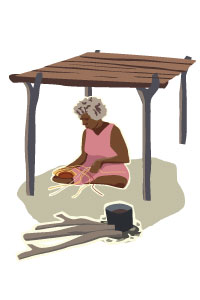
Notes from the Teaching From Country Darwin Workshop October 21 -24 2008
1 What happened:
Travel arrangements
for the workshop were difficult because people and places were involved in
the search for the missing pilot and plane from Galiwin’ku. Maratja and Gapany
eventually couldn’t come because Maratja was involved in searching on his
land, and after all the Missionary Aviation Fellowship planes were cancelled,
Gotha and Gurraŋgurraŋ arrived in the afternoon on a return charter that
had been used to bring the Gawa kids back from an excursion south.
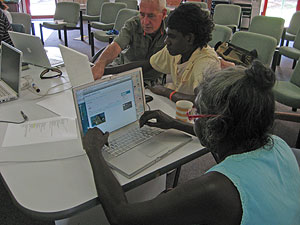
Dhanggal, Germaine and Michael developing web sites
So on Tuesday we started with Dhaŋgal who had flown QANTAS from Gove, and Yiŋiya, and his wife Waŋgurru. We had asked Yiŋiya to bring some of the kids he is looking after who turned out to be – Zoe, Miranda and Germaine - all students at Marrara Christian School. And then there was Ethan M. Gaykamaŋu who kept us on our toes. Ethan is the star of Yiŋiya’s video – the first resource on the TFC website (see www.cdu.edu.au/tfc and go to the Yolŋu resources section and click on The Big Catch). John had applied for university log-ons for all the Yolŋu consultants and they went down to ITMS – (the university’s computer centre) to collect them at about 9am, and came back at least an hour later with stories of helpful people in an understaffed centre, and many complications which seemed to revolve around Macs versus PCs (which are university standard). We started talking about the project, looking at the poster and looking at the WordPress website Trevor had prepared for individual website work (http://merricreek.com/wp/) . The poster is very useful for talking about the socio-technical aspects of the project, and everyone was amused and impressed by the recognizable images of some people. We spent much of the day looking for resources, maps photos etc, and putting them up on to various websites. The people who started early on the first day, made pages from Trevor original website (http://merricreek.com/wp/) You can see the pages for Dhaŋgal Gurruwiwi, Germaine Waŋaybuma, Gotha, Joanne Garŋgulkpuy, Miranda (Yiŋiya’s daughter) and Yiŋiya as well as the pages where Trevor John and I were mucking around trying to work out – and show - how to work the machine.
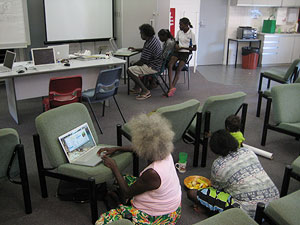
Gotha, Gurranggurrang, Yingiya, Melinda and Zoe
Later Trevor set up separate websites for some, so that they could have their tabs distributed along a menu bar (rather than as drop-down tabs – as necessary when we all shared the first trial WordPress blogsite). That went well, see details below. The web development was fun and interesting, and by Wednesday morning to my surprise, we were in a position to try out some remote teaching possibilities. We tried two possibilities: TeamViewer, and sharing websites and talking about them using Skype and the phone. That also went well, see details below. On Wednesday afternoon we invited Sarah Scott the Fine Arts lecturer who is part of the CDU team, and two member of the Advisory group - Jeanie Bell from BIITE (an Indigenous Tertiary Institute 100kms south of Darwin) and Prof Wendy Brady (Head of the School of SAIKS at CDU –which runs the Yolŋu Studies program) to afternoon tea to meet the team – or those who were present. Wendy was unable to make it, but Jeanie and Sarah met everyone, had a look at what was going on, talked about what they would like out of the project, and we gave a demonstration of the websites and remote teaching trial.
On Thursday and Friday some continued on their websites. Gotha had a meeting with Simon Niblock about her Warramiri books. I worked with Garŋgulkpuy on transcribing, translating and commenting on her (and her husband’s) recordings on Yolŋu philosophy – about Yolŋu children growing in knowledge, and the notion of bundurr. Then Dhaŋgal, Gotha, Garŋgulkpuy and Yiŋiya all made voice-to-camera statements about the project and their thoughts on Yolŋu knowledge, place, and technology. Gurraŋgurraŋ made a sound file on her reflections. Transcriptions and translations of these should all be available pretty soon. Yiŋiya also made a short Djambarrpuyŋu video about the project to upload to the TFC website, for Yolŋu who want a quick representation of the project in their own language. Trevor and I talked about changing the TFC website to include Yolŋu-user-friendly pages, and we decided to start with a short video in YM by Yiŋiya giving a brief overview of the project for interested Yolŋu.
2 Reflecting on the websites
(by the time you read this, some of the websites might be quite different, I’m just reporting on the Saturday after the workshop finished): We decided some time ago to look at the development of websites as the starting point for the digital knowledge resource work on country, mostly because we were worried that the TAMI-style solutions which required remote screen sharing would not be able to depend on the required band-width from remote settings. We preferred the TAMI-style solutions – greater flexibility, less structure (see http://www.cdu.edu.au/centres/ik/db_TAMI.html) but thought that we needed a workable fall-back position for remote teachers. This solution, teacher and students looking at the same website and talking about it over the phone, would be available anywhere with phone contact. So we were feeling our way a bit. I tried a few times in the morning to get people to talk about the wider question of what would you want to tell the world if you had a chance to do so in the project, just to think about the sort of digital objects which might be helpful in a basic sort of teaching practice. No real success, but maybe there are some statements in the videos which are still to be transcribed. I think the question is just too general. As it turned out the websites were quite varied, and some political, some didactic, some highly structured.
Gurraŋgurraŋ is making a website for her father Daymaŋu a well-known artist who we hope will be able to do some teaching from Gawa homeland centre – for both the Fine Arts and the Yolŋu Studies program at CDU. She started her website http://merricreek.com/daymangu/ with a couple of photos of Daymaŋu, and an image of one of his paintings (click on the image to see it enlarged) and a Google map of Elcho and Stephen Islands which have Warramiri estates on them.
Gotha begun with an overall plan for her website look at the different tabs she has set up at http://merricreek.com/gotha/ , most of which are empty at this stage. Note that her site is actually the name of her place, not herself. One of her main concerns is the viability of the community and the viability of its language (Warramiri) so she has a tab for her work on Warramiri books and language education. By Friday afternoon, she had enlisted the help of Ian Morris, a naturalist and ex-missionary from Galiwin’ku living locally who arrived with a huge photographic archive and they spent the afternoon swapping stories and photos.
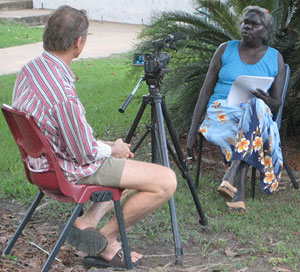
John interviewing Dhanggal
Dhaŋgal is keen to move her family to a remote homeland centre Gikal. She included on her website http://merricreek.com/dhanggal/ some notes about her Galpu clan history and art, and a link to her brother’s didgeridoo website which is probably one of the most popular didgeridoo websites internationally and full of photos and information. She talks about the need for a satellite dish. As soon as she could see the possibility of the medium, she rang someone who had come to visit her land (from an Indigenous investment company) and asked him to email her some photos he had taken during a visit to Gikal – which he did, and which she received by email attachment the next day, and included. She had had very little experience with computers, but took to the Mac laptop like a duck to water and left $500 of her consultancy payment as an initial payment for a computer of her own – which we must organize to buy directly and set up with all the right software.
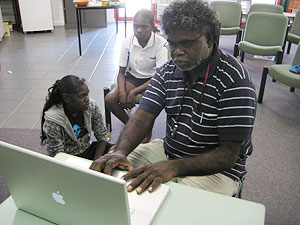
Yingiya developing a PPT with Melinda and Zoe
Yiŋiya was mostly interested in the possibilities of Powerpoint for his teaching, and continued to work on some presentations. He is currently living in Darwin teaching the Yolŋu Studies course (which is why he could bring his wife and the kids). On Thursday he gave everyone a demonstration of how to make a PowerPoint presentation into a movie (using Make Movie?) by doing a voiceover as you click from screen to screen. I was called away at a crucial moment to sort something out so I still don’t know how to do it, but everyone is impressed. Except that it seems that more recent version of PowerPoint don’t have that facility? His website is small, but with screen-sharing, he was able to open other resources – especially his PowerPoints, it was great to watch.
Garŋgulkpuy was pretty sure about what she wanted to do. She is a key figure in a Yolŋu research centre at Galiwin’ku called Yalu Marŋgithinyaraw, and she wanted her site to deal mostly with that, (although she wanted it to be her site with her name, not a site for the organization). Her two simple pages http://merricreek.com/joanne link to a video about a research project she did on Yolŋu ‘longgrassers’, a paper on Yolŋu philosophy of identity, and (using the drop-down menu under her name) the website which explains the history and practices of the Yalu centre plus Yolŋu elders’ stories of the philosophy of Yalu (commonly translated as nest but here used in a complex metaphor of land-history-connection-identity).
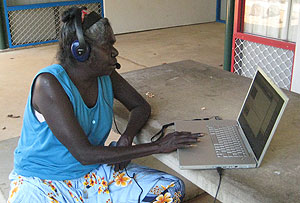
Dhanggal 'teaching' during a Skype / Teamviewer /
Web sites trial
3. Reflections on the remote teaching experiment: I was surprised and impressed by how quickly and easily Trevor and John got the remote teaching scenario up and running and everyone took to it. No one worried too much about technical hitches. We tried two of the three remote teaching scenarios which we had imaged to be workable. We didn’t try the commercial software advocated by the university (Winba) or the university and the NT Department of Education (IDL or React) because we didn’t have time to organize a trial with TLDG (the remote learning and teaching arm of the university). If we had have realized how soon we would be giving remote teaching software a go, we might have worked harder to set something up trialing the bigger proprietory software packages like Wimba. We slowly sorted out the feedback noises (the computers were pretty close together) John went off and got a head-set, Trevor found some drop-down menus on the Mac (on the teaching side) which made everything miraculously clearer to us sitting in the classroom. We moved one computer out to the concrete tables, and later up to Yiŋiya’s office in the next building to try the phone-up solution. Before long, the Skype failed to work. Skype has been banned by the university, we all had it switched off a year or so ago (too many academics chatting with their mates and using up all the band width?) so we suspect that somehow the ITMS was alerted to the fact that someone was using Skype on campus and it was (automatically?) disabled. Worse, because the log-ins which ITMS finally provided didn’t seem to be working well, a few people logged on using my Username and Password. That soon too became (automatically?) unavailable and the Yolŋu connections kept dropping out. I jokingly suggested we move to the internet café down the road in Rapid Creek next to Happy Foodland (a Chinese minimarket much patronized by Yolŋu in Darwin). By Friday this arrangement seemed to Trevor like a good idea not having to work through the university’s system (no matter how friendly and efficient are its employees). He reckoned that in the workshop we spent about a third of our time dealing with the gatekeepers. (Just as an aside, the top level of university administration is fully supportive of the project. It’s the middle levels – particularly ITMS and the finance departments which we will need to deal with. The finance department problem is to do with the ways in which Yolŋu get paid for their consultancy services, but that will be dealt with later.) The main difference between the two systems we tried (let’s call them Screen-sharing and Phone-contact-only) was of course that with phone-only the ‘teacher’ can’t control what the students see. The teacher needs to direct the students to click this or that tab, and to report back as to what they can see – so they’re all on the same page, so to speak. The main problem with the Phone-contact-only solution, was that the teacher would start talking about something (usually the map) and use their cursor to point out this or that place or a route between them, and the students couldn’t see the mouse movement. Even the novices learnt the use of the mouse to point out significant features on the screen. We just needed to un-learn that capability if we were using Skype or the phone without screen sharing. I think we can conclude that the Phone-contact-only system will definitely work, but it’s not very interactive, and gets messy when the teacher wants to use other resources – like Google earth. Very difficult to stay on the same page, them, but is the minimum level of connectivity which can make the remote teaching work. Trevor had done a bit of research about screen sharing and, out of what seemed like a vast array of solutions, chose to experiment with TeamViewer – it had worked well at our meeting at his house in Byron Bay, and worked well on our trial. Yiŋiya showed us his website, from his office in the next building, and then went on to YouTube and other repositories to show things he had been working on. We could see what he was seeing, we could see his cursor moving over objects, and we (on the receiving end of Teamviewer) could even put a large blue arrow on the screen back again for the teacher to see, if we wanted to ask a question about this or that feature of a map or photo. It worked well, but we fear that out in remote communities we won’t have the bandwidth to make the upload from the teacher’s screen sharing work quickly enough for everyone to stay tuned. John is off to Mapuru and will experiment with that with Trevor next week. Everyone seems to have a good sense of what the challenges are and the directions we are taking to find some solutions.
Gawa 1 and Gawa 2: a vignette
Gotha showed a Google earth image of the area around her land (click on the map at http://merricreek.com/gotha/?page_id=6). The long Elcho Island with the mission (established in the 1920s) at the bottom end, and her community of Gawa at the top end a couple of hours drive away on a dirt road. She also showed other areas of Warramiri land, including a place on the mainland called Gawa 1. She told the story of how her father had been murdered on Gawa 1 and people had moved to the mission (early days) and much later up to Warramiri land on the top of the island where she now lives. I immediately wanted to ask questions about place names – I learnt years ago about different Yolŋu places having the same name because of ancestral connections, and wondered whether the two Gäwas had always had the same name or whether the name of the present Gawa had been bestowed in living memory. Trevor wanted to hear about the political ructions which led to the movement of the Warramiri centre from one place to another. Among all this was Gotha’s story of the Yirritja dogs roaming together on Yirritja land (Warramiri is a Yirritja group) and deciding for a variety of quite specific reasons, to go their separate ways (and become ancestors for different Yirritja groups). Pressed later for more information, Gotha made clear that Garŋgulkpuy at the other end of the room, was the one to tell the story and handed over to her. Garŋgulkpuy started telling stories about the currents swirling about in Arnhem Bay, and the two women – one here, and one here (pointing to the Google image) who supervise the movements of the current. It was one of those situations where a fascinating story was followed by a keen question which was answered by another fascinating story which seemed, at least for the moment, to have nothing to do with the original story. It puts the student into silent wondering, and as Yiŋiya points out in his video – a position where they know to look and listen and not ask any more questions, for now, at least.
A few lessons:
1. The Gawa story made clear that a group of knowledge authorities (rather than a single individual) greatly enriches the teaching end. They ruminate over the resources together and use each other to elaborate the stories, and play out the politics of (re)presentation which is so important for students learning about the multiple Yolŋu worlds.
2. Yiŋiya’s switching to resources outside of his website made screen sharing look indispensable. Trying to move from source to source using Phone-contact-only is really confusing.
3. We occasionally fell back upon well-known dependable software. When John passed Trevor and Gotha working on an alphabet-wordlist for her Warramiri language, he suggested that they revert to Microsoft Word to get it sorted. It worked well. Later John pointed out that NeoOffice (an open source equivalent of Microsoft Word?) has all that functionality and in addition is more tolerant of Yolŋu words in its dictionary system.
4. Yiŋiya is keen on PowerPoint. He uses it in his classes at CDU, and showed us how to give powerpoint presentations pace and voice through the export function. We reconsidered the uses of some much-reviled software.
5. The best Yolŋu stories come out of maps. Whenever a google image of Yolŋu land pops up, Yolŋu cluster around and start telling stories, pointing things out, reminding each other, deferring, making agreement, doing all the right things required of decent Yolŋu knowledge production.
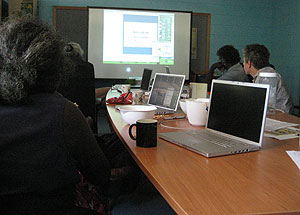
Yingiya sharing his PPT method
6. Each Yolŋu participant has their own vision. Gotha’s is didactic, she wants to tell people including her own, about Warramiri language and culture and has the structure of her website organized. She is a strong Christian. Gurraŋgurraŋ made clear that she is only there to help her father. She was happy to have her voice recorded, but not video. If they were to buy a computer, it would be her father who would do it. He is an artist, but understands that Balanda know very little about what Yolŋu art means, or what it does, and is happy to talk about it, if he’s properly recognized. Yiŋiya as Trevor pointed out, has a movie maker’s vision. He wants to use the new media to keep his culture strong. We watched videos of young Yolŋu men doing rap dancing at the Milingimbi music festival. Yiŋiya was impressed by their style and their commitment and wanted to find ways of focusing some of that commitment on the boys’ understanding and performance of ancestral song and dance. Garŋgulkpuy’s vision is of the viability of Yolŋu knowledge traditions and of creating a space for yolŋu knowledge authorities in contemporary governance, (see her work on gambling). Maratja and Frank, if they had been available would have come up with something quite different again, I’m sure. 7. We can’t expect the Yolŋu workshoppers to go home and continue to work on their websites by themselves. It is important for us to keep up with them all.
In the IKRMNA project (www.cdu.edu.au/ik) we found ourselves after a year, to be trying to support and understand a dozen or so emerging solutions, of which we were finally able to bring only 3 or 4 to some sort of conclusion. In this project we are also quickly drawing in the small list of workable solutions. We only have a year to finish and understand this, so it’s a bit tight.